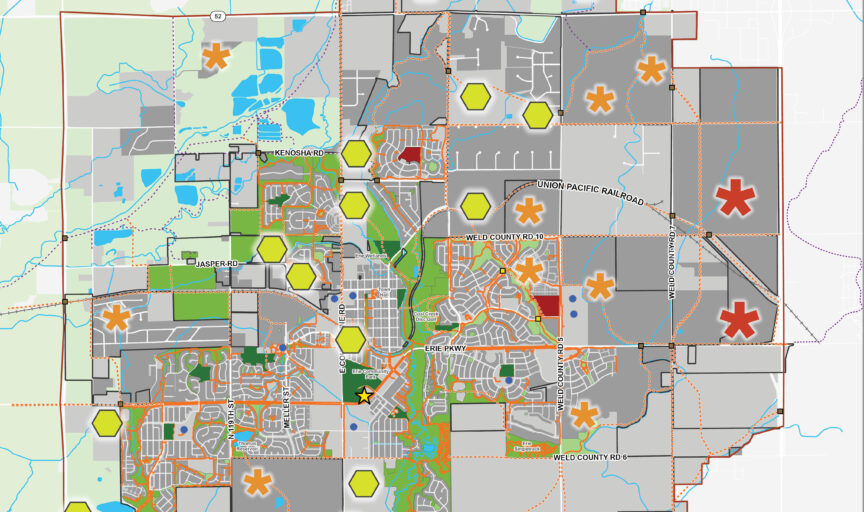Town of Erie Announces PROST Plan Approval with DTJ
On August 26, 2025, the Town of Erie, CO, marked a significant moment with the approval of its Parks, Recreation, Open Space, and Trails (PROST) Strategic Plan.

When this comprehensive plan update was first launched—the first major revision since 2016—a familiar challenge for rapidly growing Front Range communities emerged: how do you balance current needs with anticipated growth while ensuring every voice in your diverse community is heard?
Over the course of 10 months, DTJ partnered with Erie to implement an engagement approach that generated meaningful input.

A Strategic Framework for Inclusive Engagement
The centerpiece of Erie’s engagement strategy was to invite, inform, and engage community members. To execute this, we utilized pop-up events, one-on-one interviews, focus groups, the Community Questionnaire, and Erie’s interactive PROST map. By reflecting community feedback in design and planning decisions, the process not only informed the plan but empowered residents to become advocates for future Erie initiatives.
Erie Community Open House
The Erie Community Open House was held at the Erie Community Center Gymnasium, a space frequently used by residents for many recreational activities. Rather than a traditional presentation format, we designed seven interactive engagement stations anchored around a large walkable map at the center. Each station focused on a specific aspect of the PROST system, engaging 80-100 community members from children to seniors.
The Walkable Map
The large-scale map of Erie’s existing PROST system became a natural gathering point for residents. People “walked” through their community’s recreation system, physically pointing and tracing their neighborhoods and trails, saying, “We need something here,” or “This trail should connect to that one.” The hands-on format let residents visualize spatial relationships to suggest specific locations for new facilities and share insights about underutilized spaces.

Funding Prioritization and Future Programming Made Visual
Rather than abstract discussions about budget and desired spaces, we used interactive exercises to make community input more tangible.
Marble jar exercises were used to understand prioritization, where participants allocated marbles to different categories like Acquire More Open Spaces or Add More Recreation Programs. Sticky dot exercises focused on future programming preferences and household insights, with questions such as, “Which Erie PROST indoor spaces do you currently use?” and “Which outdoor spaces would you like to see more of?” Being hands-on helped residents recognize the trade-offs while making their choices concrete and measurable.

Children as Stakeholders
Children’s drawings revealed ideas about play and community spaces that adults often overlook. It’s a reminder that the people who spend the most time at playgrounds might just have the best thoughts about how to improve them.

Arbor Day
Recognizing the need for broader engagement, we attended Erie’s Arbor Day event, where the outdoor setting attracted residents naturally interested in trail systems and connectivity. The pop-up booth allowed for informal, yet perceptive, conversations with community members who might not attend formal meetings.
Feedback highlighted a strong preference for funding enhanced trail systems, new parks on vacant Town-owned land, and deferred maintenance. Key interests included expanded playgrounds, dog parks, singletrack, and regional loop trails, along with connections to recreation facilities and trail underpasses. Residents also supported potential developments like the Arapahoe and Cheyenne practices, Bison Trail, a Sculpture Park near Coal Creek Park, and an outdoor aquatics facility.
The event reinforced the need for expanding Erie’s trail network and developing more recreational amenities, especially on vacant Erie-owned land.


Town Fair
Findings at the Erie Town Fair mirrored the trends seen at Arbor Day, underscoring recurring objectives: the need for more open space, expanded trail systems (especially connections to schools), and new recreational amenities (disc golf and dog parks).
Pop-up events played a key role in highlighting patterns that emphasize the need for strategic planning in Erie’s growth, ensuring infrastructure continually evolves.

Expanding Beyond Traditional Venues
Focus Groups
Targeting the right audiences was crucial for Erie to meet the needs of those it serves and engages with. This included identifying focus groups: groups of people who are affected by the outcome. These provided key opportunities to learn deeply from a carefully selected subset of the community.
Among the many focus groups held, the History and Culture group emphasized preserving key landmarks such as the Erie High School Homestead and the historic blacksmith shop at Canfield Wise. Revitalizing cultural spaces like the Pure Street House and the Lorraine David Children’s Library, along with expanding programs like the rail bike tours, reflected a strong desire to connect residents with Erie’s history. Their guidance ensured that Erie’s unique story remains a visible and celebrated part of community life.

Cultural Academy
An often overlooked aspect of municipal planning is internal stakeholder engagement. We facilitated a Cultural Academy event specifically for Erie staff to explore differences between staff and public perspectives. It also provided a pathway to address the operational and maintenance implications of community desires and build internal alignment around community priorities.

Building Trust Through Transparency
Set to guide the town over the next decade, Erie’s engagement success illustrates that when municipalities invest in comprehensive, inclusive engagement strategies, communities respond with thoughtful, actionable input. By working with rather than imposing goals, we’ve been able to cultivate a collaborative environment where residents actively shape the future. The clear priorities identified through this process offers a replicable model: meet people where they are, make abstract concepts tangible, and create multiple ways for different types of community members to contribute their voices.
For more information, visit The Town of Erie Playbook.


 BACK TO BLOG
BACK TO BLOG